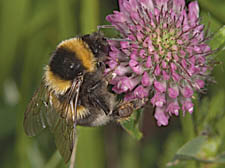|
|
 |
| |
Can curbing pesticides help win fightback of the bumblebees?
Their numbers are down, but gardeners could help bees recover, says
Tom Moggach
ARE pesticides, genetically modified crops or mobile phones the cause?
No one is sure, but one thing is for certain: the plight of the bee has hit the headlines.
I’m no expert on bees and won’t pretend otherwise.
But for the urban gardener, the facts speak for themselves – these insects are vital pollinators, and we should do our best to help.
But before the practical advice, let’s get one thing straight. It’s the bumblebee, not the honeybee, which will benefit most from our efforts.
Why? Well, firstly it’s down to their diet. Bumblebees are the bigger, fluffier species. They live wild in small colonies of just a few hundred, and often forage alone.
Honeybees, in contrast, live in hive colonies of tens of thousands.
They prefer larger clumps of flowers, for example a row of flowering lime trees, and forage in large groups.
So, unless you have a huge garden or allotment, it’s more practical to help the bumblebee by growing a selection of plants that they can visit to drink their nectar.
The second factor is language. Honeybees, when they find a source of food, can tell the others where to go.
They use their “waggle dance” to pinpoint the location. Bumblebees, in contrast, stumble across food and have no method of tipping off the other bees.
“Bumblebees like deep flowers as they have long tongues,” explains beekeeper Toby Mason, who keeps hives in Regents Park (www.purefood.co.uk). “Lavender, honeysuckle, foxgloves, brambles and bluebells are all great for bumblebees.”
For a longer list, check out the website for Jordans, the cereal company, who are running a bee campaign and are sending out bee-friendly plants (www.jordansbigbuzz.co.uk).
Bear in mind that they flower at different times, so the ideal is a mixture.
For another approach, consider their habitat. Bumblebees make their own nests.
If you have a garden, try keeping a section wild, with plenty of nooks and crannies. “They like a warm, dry, insulated and well-drained space the size of a football,” explains Mason.
To make your own nest, he says, you can try old bird boxes, a few bricks with a tile on top or an upturned flowerpot.
Fill them with nesting material such as dry moss, fine hay or shredded paper. Experiment with a few different ideas, he adds, to increase your chances of success.
Finally, don’t panic if you find a nest hidden in your garden.
Bumblebees rarely sting and it can easily be moved.
Get in touch with the North London Beekeepers Association
(www.beekeeping.org.uk 020 7485 4070).
Not long ago, there were 25 species of bumblebee in Britain. Three are already extinct.
There has been around a 70 per cent decline in bumblebee numbers since the 1970s.
“Think wild and think no chemicals and you will have happy healthy insects, including bumblebees, in your garden,” says Mason.
www.cityleaf.co.uk |

|
 |
| |
|
 |
|

